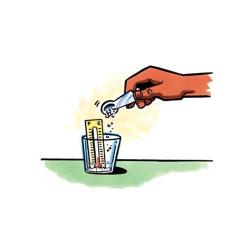Source Institutions
Source Institutions
Add to list Go to activity

Learners add calcium chloride to a baking soda solution and observe an increase in temperature along with the production of a gas and a white precipitate. These are all signs of a chemical reaction. Learners can quantify the results of the reaction by using a thermometer to measure the temperature change. Learners also design their own experiment to alter the reaction and measure how it affects the change in temperature. [Activity is publicly available through a web crawler capture on Archive.org. Activity write-up only, images are unavailable.]
- 5 to 10 minutes
- 30 to 45 minutes
- $1 - $5 per group of students
- Ages 8 - 14
- Activity, Experiment/Lab Activity, Lesson/Lesson Plan
- English
Quick Guide
Materials List (per group of students)
- Baking soda solution
- Calcium chloride
- Water
- Thermometer
- Graduated cylinder, 50 ml
- ½, ¼, and 1/8 Teaspoons
- 2 Small cups
- Waste container
- Paper towels
- Student Activity Sheet
- Goggles
Subjects
-
Mathematics
-
Data Analysis and Probability
- Data Analysis
- Data Collection
-
Measurement
- Units of Measurement
-
Data Analysis and Probability
-
Physical Sciences
-
Heat and Thermodynamics
- Heat and Temperature
-
Chemistry
- Chemical Reactions
- Solutions
-
States of Matter
- Gases
-
Structure and Properties of Matter
- Elementary Particles and Nuclear Physics
-
Heat and Thermodynamics
-
The Nature of Science
-
The Scientific Process
- Asking Questions
- Conducting Investigations
- Gathering Data
- Formulating Explanations
- Communicating Results
-
The Scientific Process
Audience
To use this activity, learners need to:
- see
- read
- touch
Learning styles supported:
- Involves hands-on or lab activities
Other
Components that are part of this resource:
This resource is part of:
Access Rights:
- Free access
By:
- Kessler, James H. ; Galvan, Patricia M.
Rights:
- All rights reserved, American Chemical Society, 2007
